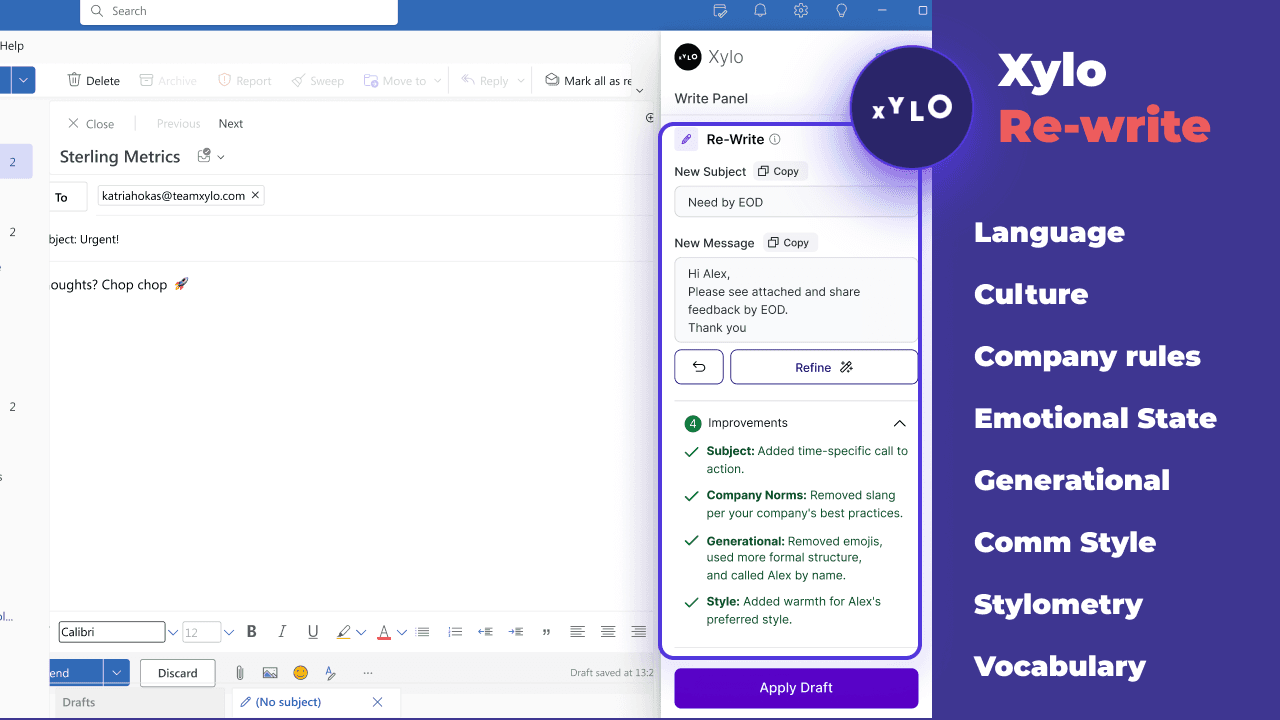How AI Email Writers Are Revolutionizing Workplace Communication
August 1, 2024
How AI Email Writers Are Revolutionizing Workplace Communication
Xylo for Business Communication
Introduction:
Imagine a scenario where your well-intentioned email to a colleague in another country inadvertently causes offense due to cultural nuances, or where your message to a Gen Z team member falls flat because it's peppered with outdated references. These communication pitfalls are more common than you might think, and they're costing businesses dearly. But what if there was a way to bridge these gaps effortlessly, ensuring clear, culturally appropriate, and effective communication every time? Enter the world of AI Email Writers and AI Productivity Tools, revolutionizing Professional Communication in our diverse, modern workplaces.
The Problem:
Cross-cultural and intergenerational communication in the workplace is fraught with potential misunderstandings. A study by the Economist Intelligence Unit found that 64% of executives believe that poor communication or ineffective collaboration is a primary source of workplace failures. Moreover, research from Gallup indicates that poor communication costs U.S. companies up to $550 billion annually. These statistics underscore the critical need for effective communication tools in today's diverse business environment.
The Solution:
AI-powered communication tools, particularly AI Email Writers, are emerging as game-changers in navigating the complexities of workplace communication. These sophisticated AI tools in Business Communication can help bridge linguistic, cultural, and generational gaps, ensuring clearer, more effective, and more inclusive communication.
Let's explore how AI is addressing the key challenges of written communication in diverse workplaces:
1. Overcoming Language Barriers
Challenge: In multinational companies, employees often need to communicate in languages that aren't their native tongue, leading to potential misunderstandings.
Solution: AI Email Writers with multilingual capabilities
How It Helps:
Translates and refines messages across languages, maintaining context and intent
Suggests culturally appropriate phrases and idioms
Checks for grammatical accuracy in multiple languages
Example: Xylo AI, an AI-powered writing assistant, helps companies ensure clear communication across their global teams. Its advanced language AI can detect subtleties in tone and suggest improvements, helping non-native speakers communicate more effectively.
2. Navigating Cultural Nuances
Challenge: What's polite in one culture may be offensive in another, making cross-cultural communication a minefield.
Solution: AI tools with cultural intelligence
How It Helps:
Analyzes the cultural context of both sender and recipient
Suggests culturally appropriate greetings, sign-offs, and expressions
Alerts users to potentially sensitive phrases or topics
Example: Xylo AI, incorporates cultural intelligence algorithms to help users craft messages that resonate across different cultural contexts, reducing the risk of unintended offense or miscommunication.
3. Bridging Generational Gaps
Challenge: Different generations often have distinct communication styles and preferences, which can lead to misunderstandings or disconnect.
Solution: AI-powered communication style adapters
How It Helps:
Analyzes the recipient's communication style based on previous interactions
Suggests appropriate tone, formality level, and language use for different generations
Offers alternatives to outdated or overly trendy expressions
Example: IBM's Watson Tone Analyzer, while not specifically an email tool, demonstrates how AI can detect and adapt to different communication styles. This technology could be applied to email writing to bridge generational communication gaps effectively.
4. Ensuring Clarity and Conciseness
Challenge: In a fast-paced work environment, messages often lack clarity or are too verbose, leading to confusion and wasted time.
Solution: AI-powered editing and summarization tools
How It Helps:
Suggests ways to simplify complex sentences
Highlights areas that may be unclear or ambiguous
Offers concise alternatives to wordy expressions
Example: Hemingway Editor, while not AI-powered, shows how automated tools can improve clarity in writing. AI Email Writers are taking this concept further, offering real-time suggestions for clearer, more concise communication.
5. Maintaining Consistency in Brand Voice
Challenge: Ensuring all employees communicate in a consistent brand voice can be challenging, especially in large organizations.
Solution: AI tools with brand voice integration
How It Helps:
Learns and applies the company's preferred communication style
Suggests phrases and tones that align with the brand voice
Alerts users when their message deviates from the established brand voice
Example: Persado, an AI-powered language generation platform, helps companies like JPMorgan Chase maintain a consistent brand voice across all customer communications, demonstrating the potential for AI in maintaining communication consistency.
Practical Advice for Implementation:
Start with a pilot program: Introduce AI Email Writers to a small team first to gauge effectiveness and gather feedback. You can contact Xylo AI to get a free trial for your whole company and team members.
Provide training: Ensure employees understand how to use the AI tools effectively and when human judgment should override AI suggestions.
Encourage feedback: Regularly solicit input from users to continually improve the AI's performance and relevance.
Combine with human expertise: Use AI as a supplement to, not a replacement for, human communication skills and cultural awareness training.
Stay updated: As AI technology evolves rapidly, keep your tools updated to benefit from the latest advancements in natural language processing and cultural intelligence.
Conclusion:
In an increasingly diverse and globalized business world, effective written communication is more crucial than ever. AI Email Writers and other AI Productivity Tools are not just conveniences; they're becoming essential instruments in bridging linguistic, cultural, and generational gaps. By leveraging these AI tools in Business Communication, companies can significantly reduce misunderstandings, improve collaboration, and ultimately drive better business outcomes.
As we navigate the complexities of modern workplace communication, AI stands as a powerful ally, helping us connect more effectively across our differences. The future of Professional Communication is here, and it's powered by AI.
Related articles




